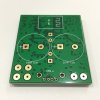I couldn't find anything on Google so to save others the time required to find out anything decent about this small module I'm creating this thread which will be indexed by Google.
STATUS: THIS MODULE IS WORKING (with issues)
The JDY-10 uses the TLSR8266 chip which has an impressive specification and low power requirements. It's currently the cheapest BLE module on Aliexpress. As with all these various modules, key lies in the quality of the firmware.
Eventually I found a Chinese datasheet which I've attached. Google will do a pretty good translate of it. You can use the URL to find a store which reveals the company name and then google that for the company URL. The price/unit is $0.99 direct.
The chip runs at a default baud of 115,200. There is an AT+BAUD command to change it. I wish they'd used 9,600 as 115.2k isn't available with PIC MCU RC oscillator's running at 8MHz.
You can change the BLE exposed name but the last character is always missed off, so add a random character.
On boot it prints "Star...".
To force command mode (in case of active connection) the pin B0 (according to the datasheet) must be grounded.
There is a sleep mode (two states) but they doesn't work. It appears to be part implemented in that the commands work (and pin to "wake" it up) however in "sleep" mode the Bluetooth is still active and accepting a connection. UART still works and the LED outputs continue output. Since the device consumes ~10mA I worked around this by driving the device directly from a MCU pin.
I had the key parts related to pin B0 translated and I've included them below.
µÍµçÆœ AT ģʜ,ĬÈÏžßµçÆœ
AT mode of Low level is default high level
ŽËÒýœÅÔÚÒÑÁ¬œÓÇé¿öϲ»ÐèÒª·¢ AT ÖžÁîµÄ»°, ¿ÉÒÔ²»
ÓùÜ,Ðü¿ÕŸÍÐÐ
The pins can be ignored and suspended if there is no required to send the AT command under the connected condition.
µ±ÒªÇóÔÚÁ¬œÓµÄ׎̬·¢ AT ÖžÁîʱ,ŸÍœ« B0 ÒýœÅ±£³Ö
µÍµçÆœ,ŸÍœøÈë AT ģʜ,Óû§ŽËʱŸÍ¿ÉÒÔ·¢ËÍ AT Öž
Áî,Òª·¢ÍžŽ«ÊýŸÝʱŸÍœ« B0 ±£³ÖžßµçÆœ,ŸÍÁ¢ŒŽœøÈë
ÍžŽ«Ä£Êœ
When it require sending the AT command in the state of the connection,
then just keep low level for the B0 pin, it enters the AT mode,and the users can send AT command at this time.
When it require to send passthrough data,then keep the B0 maintain a high level,
then it will immediately into passthrough mode.
ÊÇ·ñÔÚÎŽÁ¬œÓµÄÇé¿öÏ·¢ AT ÖžÁîÐèÒªœ« B0 ±£³ÖµÍµç
Ɯ ?
Does it need to keep the BO low level if we want to send the AT command at the state of unconnected?
Žð:²»ÐèÒª,Ä£¿éÔÚÎŽÁ¬œÓµÄ׎̬ÏŸÍÊÇ AT ģʜ,ÓÃ
»§²»ÐèÔÚÒÑÁ¬œÓÇé¿öÏ·¢ËÍ AT ÖžÁî ,B0 ÒýœÅ¿ÉÒÔÐü
¿Õ
Answer: no, the module is AT mode in an unconnected state.
B0 pins can be suspended if the user does not need to send the AT instruction under the connected condition.
ATÖžÁî¿ØÖÆÒýœÅ
Á¬œÓ׎̬Ï£ºµÍµçÆœATģʜ
ÍžŽ«Ê±£ºÐèÒªÀžß
ŽËÒýœÅÈçÓò»ÉÏ£¬¿ÉÐü¿Õ
AT command control the pins
Under connected condition:low level AT mode
Passthough condition:need draw high
The pins can be suspended if it do not be used.
STATUS: THIS MODULE IS WORKING (with issues)
The JDY-10 uses the TLSR8266 chip which has an impressive specification and low power requirements. It's currently the cheapest BLE module on Aliexpress. As with all these various modules, key lies in the quality of the firmware.
Eventually I found a Chinese datasheet which I've attached. Google will do a pretty good translate of it. You can use the URL to find a store which reveals the company name and then google that for the company URL. The price/unit is $0.99 direct.
The chip runs at a default baud of 115,200. There is an AT+BAUD command to change it. I wish they'd used 9,600 as 115.2k isn't available with PIC MCU RC oscillator's running at 8MHz.
You can change the BLE exposed name but the last character is always missed off, so add a random character.
On boot it prints "Star...".
To force command mode (in case of active connection) the pin B0 (according to the datasheet) must be grounded.
There is a sleep mode (two states) but they doesn't work. It appears to be part implemented in that the commands work (and pin to "wake" it up) however in "sleep" mode the Bluetooth is still active and accepting a connection. UART still works and the LED outputs continue output. Since the device consumes ~10mA I worked around this by driving the device directly from a MCU pin.
I had the key parts related to pin B0 translated and I've included them below.
µÍµçÆœ AT ģʜ,ĬÈÏžßµçÆœ
AT mode of Low level is default high level
ŽËÒýœÅÔÚÒÑÁ¬œÓÇé¿öϲ»ÐèÒª·¢ AT ÖžÁîµÄ»°, ¿ÉÒÔ²»
ÓùÜ,Ðü¿ÕŸÍÐÐ
The pins can be ignored and suspended if there is no required to send the AT command under the connected condition.
µ±ÒªÇóÔÚÁ¬œÓµÄ׎̬·¢ AT ÖžÁîʱ,ŸÍœ« B0 ÒýœÅ±£³Ö
µÍµçÆœ,ŸÍœøÈë AT ģʜ,Óû§ŽËʱŸÍ¿ÉÒÔ·¢ËÍ AT Öž
Áî,Òª·¢ÍžŽ«ÊýŸÝʱŸÍœ« B0 ±£³ÖžßµçÆœ,ŸÍÁ¢ŒŽœøÈë
ÍžŽ«Ä£Êœ
When it require sending the AT command in the state of the connection,
then just keep low level for the B0 pin, it enters the AT mode,and the users can send AT command at this time.
When it require to send passthrough data,then keep the B0 maintain a high level,
then it will immediately into passthrough mode.
ÊÇ·ñÔÚÎŽÁ¬œÓµÄÇé¿öÏ·¢ AT ÖžÁîÐèÒªœ« B0 ±£³ÖµÍµç
Ɯ ?
Does it need to keep the BO low level if we want to send the AT command at the state of unconnected?
Žð:²»ÐèÒª,Ä£¿éÔÚÎŽÁ¬œÓµÄ׎̬ÏŸÍÊÇ AT ģʜ,ÓÃ
»§²»ÐèÔÚÒÑÁ¬œÓÇé¿öÏ·¢ËÍ AT ÖžÁî ,B0 ÒýœÅ¿ÉÒÔÐü
¿Õ
Answer: no, the module is AT mode in an unconnected state.
B0 pins can be suspended if the user does not need to send the AT instruction under the connected condition.
ATÖžÁî¿ØÖÆÒýœÅ
Á¬œÓ׎̬Ï£ºµÍµçÆœATģʜ
ÍžŽ«Ê±£ºÐèÒªÀžß
ŽËÒýœÅÈçÓò»ÉÏ£¬¿ÉÐü¿Õ
AT command control the pins
Under connected condition:low level AT mode
Passthough condition:need draw high
The pins can be suspended if it do not be used.
Attachments
Last edited:



